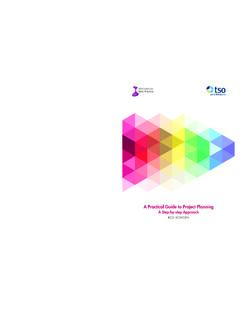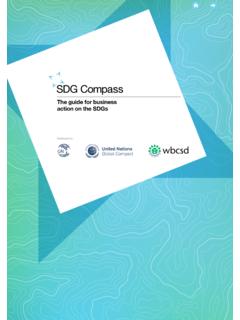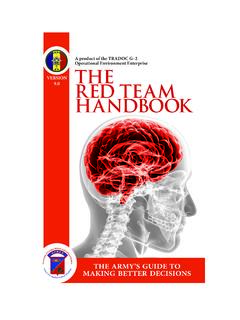Transcription of Stakeholder Analysis - World Health Organization
1 Health REFORMTOOLS SERIESGUIDELINES FOR CONDUCTING AStakeholderAnalysisA Partnershipsfor Health collaboration with:Development Associates Inc. n Harvard School of Public Health n HowardUniversity International Affairs Center n University Research Co., Associates Inc. n 4800 Montgomery Lane, Suite 600 n Bethesda, MD20814 n Tel: 301-913-0500 n Fax: 301-652-3916 Funded by:The Agency for International DevelopmentStakeholder AnalysisiGuidelines forConducting aStakeholderAnalysisPrepared by:Kammi SchmeerAbt Associates Reform Tools Seriesii Stakeholder Analysis MissionThe Partnerships for Health Reform (PHR) Project seeks to improve people s Health in low- andmiddle-income countries by supporting Health sector reforms that ensure equitable access toefficient, sustainable, quality Health care services.
2 In partnership with local stakeholders, PHRpromotes an integrated approach to Health reform and builds capacity in the following key areas:>Better informed and more participatory policy processes in Health sector reform;>More equitable and sustainable Health financing systems;>Improved incentives within Health systems to encourage agents to use and deliverefficient and quality Health services; and>Enhanced Organization and management of Health care systems and institutions tosupport specific Health sector advances knowledge and methodologies to develop, implement, and monitor healthreforms and their impact, and promotes the exchange of information on critical Health is implemented by Abt Associates Inc.
3 , under Contract No. HRN-C-00-95-00024, Project , for the United States Agency for International Development (USAID), in collaboration withDevelopment Associates, Inc., Harvard School of Public Health , Howard University International AffairsCenter and University Research Co., copies of this and other PHR publications can be requested from PHR s Resource Centervia email at or downloaded from the project s website 1999 Recommended CitationSchmeer, Kammi. 1999. Guidelines for Conducting a Stakeholder Analysis . November , MD: Partnerships for Health Reform, Abt Associates AnalysisiiiTable of ContentsAcknowledgements.
4 VIntroduction .. 1 Stakeholder Analysis at a Glance .. 3 Step 1: Planning the Process .. 5 Step 2: Selecting and Defining a Policy .. 7 Step 3: Identifying Key Stakeholders .. 8 Step 4: Adapting the Tools .. 10 Step 5: Collecting and Recording the Information ..13 Step 6: Filling in the Stakeholder Table .. 14 Step 7: Analyzing the Stakeholder Table .. 17 Step 8: Using the Information .. 20 Bibliography .. 27 Annex A: Sample General List of Stakeholders .. 29 Annex B: Definitions of Stakeholder Characteristics and Instructions for Fillingin Stakeholder 31 Annex C: Sample Stakeholder Table.
5 33 Annex D: Sample Stakeholder Interview Questionnaire .. 35 Annex E: Sample Information Transfer Reference Chart .. 37iv Stakeholder AnalysisStakeholder AnalysisvAcknowledgmentsI would like to thank Derick Brinkerhoff of Abt Associates Inc. for his guidance in the process ofdeveloping the Stakeholder Analysis in Ecuador and these guidelines. I would also like to thank PHR scounterparts in India (Samarthan and the Society for Participatory Research in Asia (PRIA)) and Ecuador(BDO Stern and the Ministry of Health ) for assisting in the development and implementation ofstakeholder analyses exercises in their respective countries.
6 Their input was a valuable contribution toPHR s experience in conducting Stakeholder analyses, which led to the development of these Analysis1 Introduction Politics, as much or more than technicalinformation, drives Health sector reform. This is trueat the sector, institutional and facility levels, wherepolitics directly affects the ability of policymakersand managers to develop and implement necessaryreforms. Yet many policymakers and managers inthe Health sector are not trained to deal with politics nor is there information available on howto manage the political process inherent to healthsector developing this document, Partnerships forHealth Reform (PHR) addresses one aspect ofmanaging the politics of the reform process: theneed for information on key players who have aninvestment in proposed reforms.
7 Policy makers andmanagers can use Stakeholder Analysis to identifythese key players or stakeholders; predict whetherthey might support or block the implementation ofhealth reforms; and develop strategies to promotesupportive actions and decrease opposing actionsbefore attempting to implement major reform at thenational, regional, local, or facility purpose of this document is to help policymakers, managers, and their working groupsconduct an objective and systematic process forcollecting and analyzing data about key healthreform stakeholders. It should be noted, however,that even with application of these guidelines andthe systematic methodology presented here,information produced by a Stakeholder Analysis isalways somewhat subjective since it is based onwhat stakeholders communicate to analysts.
8 Theseguidelines, however, do include suggestions forchecking the consistency of answers and othermechanisms to ensure that information is obtainedand analyzed as objectively as document was developed based on athorough review of the Stakeholder Analysis , politicalmapping, and policy process literature, as well asactual PHR field experience in conductingstakeholder analyses. ( Health reform stakeholderanalyses were conducted with PHR support inEcuador and India). The result is a document withinstructions and tools that are supported byacademic theory and real-life guidelines present a methodology thatyields useful and accurate information on healthreform stakeholders.
9 (This methodology can befollowed even when conducting a stakeholderanalysis with limited time or resources.) Theinformation resulting from the Analysis can be usedto do the following:>Provide input into other analyses ( ,strategic planning, institutionalassessment, broader political analyses);>Develop action plans to increase supportfor a reform policy; or>Guide a participatory, consensus-buildingprocess (by sharing the informationobtained with the stakeholders andencouraging discussion on how to addressthe concerns of the opposition).The application of these guidelines is intendedto result in policy makers and managers who aremore informed about the political environmentsurrounding their reforms and are better prepared totake action to ensure the full implementation ofhealth sector Stakeholder AnalysisStakeholder Analysis3 Stakeholder Analysis at a GlanceWhat is Stakeholder Analysis ?
10 Stakeholder Analysis is a process ofsystematically gathering and analyzing qualitativeinformation to determine whose interests should betaken into account when developing and/orimplementing a policy or is a Stakeholder ? Actors (persons ororganizations) who have a vested interest in thepolicy that is being promoted are consideredstakeholders in the process. These stakeholders or interested parties can usually be grouped into thefollowing categories: international, public, nationalpolitical, commercial/private, nongovernmentalorganization (NGO)/civil society, labor, and Stakeholder characteristics areanalyzed?

















